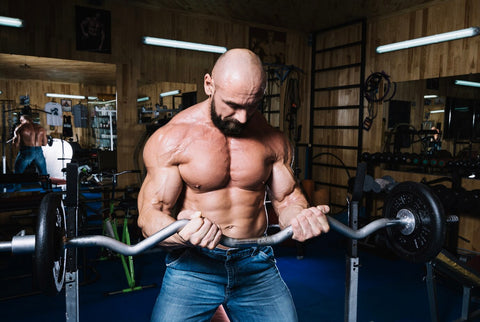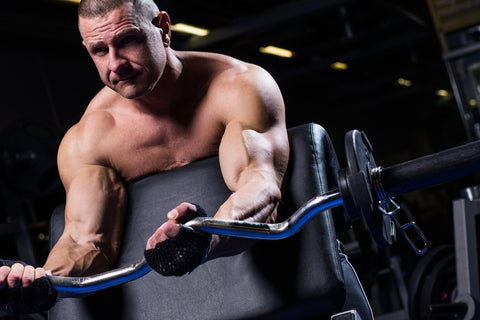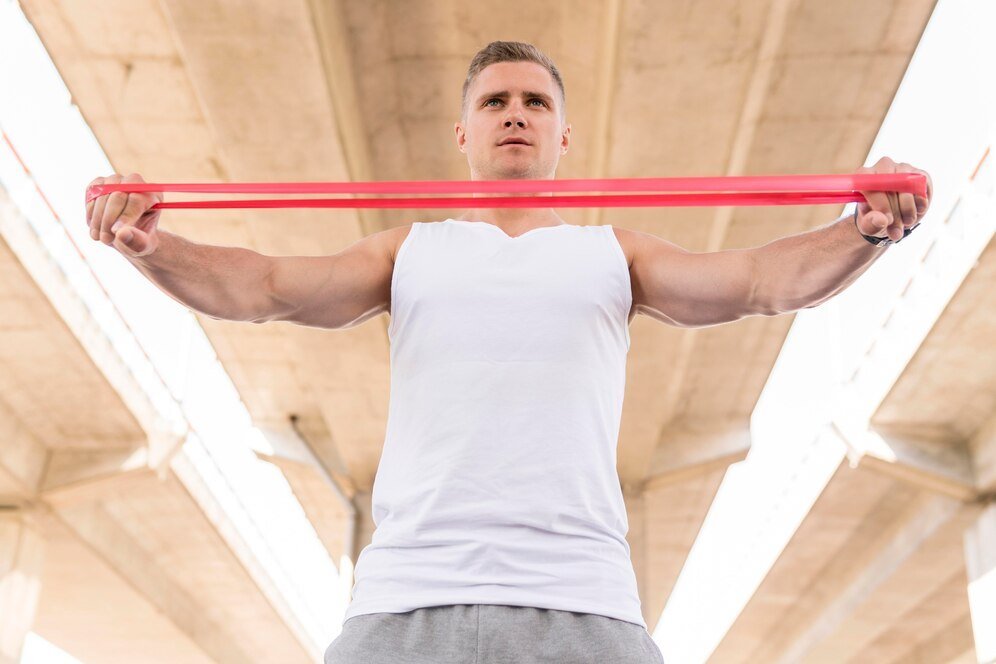Ever find yourself wishing for a straightforward exercise that could turn those average arms into sculpted masterpieces?
Well, cue the spotlight on the Barbell Bicep Curl.
Just imagine this moment – you, standing tall, hoisting that barbell, and your biceps responding with a triumphant "hello" in the mirror.
But here's the kicker – are you getting the most out of this classic move?
Let's break down the nitty-gritty of the Barbell Bicep Curl.
What Is A Barbell Bicep Curl?
A barbell bicep curl is a simple arm exercise where you stand and lift a barbell with both hands, bringing it up towards your chest by bending your elbows.
This targets your biceps, the muscles in the front of your upper arms. Keep your back straight, lift the barbell with an underhand grip (palms facing up), and lower it back down in a controlled manner.
It's a great way to strengthen and tone your biceps.
How To Do Barbell Bicep Curls?

Here is a step-by-step guide on how to do the barbell bicep curls:
Set-Up:
- Stand with your feet shoulder-width apart. Keep your back straight and core engaged.
- Hold a barbell with an underhand grip (palms facing up), hands placed slightly wider than shoulder-width apart.
Grip and Hand Placement:
- Grasp the barbell with both hands, ensuring your grip is secure and comfortable. Your palms should be facing forward.
Starting Position:
- Allow the barbell to hang at arm's length in front of you, keeping your elbows close to your torso.
Elbow Position:
- Keep your elbows stationary throughout the movement. Avoid letting them flare out; instead, keep them close to your body.
Curling the Bar:
- In a controlled manner, exhale and curl the barbell towards your chest by flexing your biceps. Keep your upper arms stationary.
Full Contraction:
- Squeeze your biceps at the top of the movement to ensure a full contraction. The barbell should be close to your chest.
Lowering the Bar:
- Inhale and slowly lower the barbell back to the starting position, maintaining control over the movement.
Full Extension:
- Allow your arms to extend fully, but without completely locking out your elbows, to keep tension on the biceps.
Repetitions:
- Perform the desired number of repetitions. Beginners may start with 3 sets of 8-12 repetitions.
Benefits of Barbell Biceps Curls

Let’s take a look at the key benefits and advantages barbell curls bring to the table:
1. Bigger Biceps & Stronger Arms
Barbell bicep curls specifically target the biceps, helping to build muscle mass in your arms.
Regularly incorporating this exercise into your routine can contribute to more prominent and defined biceps, giving your arms a strong and toned appearance.
2. Functional Strength for Daily Tasks
Strengthening your biceps through barbell curls enhances your ability to perform daily activities like lifting groceries or carrying items.
The functional strength gained can make everyday tasks feel easier and more manageable.
3. Versatile & Accessible Exercise
Barbell curls are a versatile exercise that can be easily incorporated into various workout routines. Whether you're at the gym or working out at home, all you need is a barbell.
This accessibility makes it a convenient choice for those looking to enhance their arm strength.
4. Improved Grip Strength
Gripping the barbell during curls not only works the biceps but also engages the muscles in your forearms and hands, improving overall grip strength.
This can be beneficial for activities that require a strong and secure grip.
5. Caloric Burn & Metabolic Boost
Performing compound movements like barbell bicep curls can contribute to an increased calorie burn during and after your workout.
Building muscle also boosts your metabolism, which means you continue to burn calories even at rest. It's a win-win for those aiming to support weight management goals.
Who Should Do Barbell Biceps Curls?
Barbell bicep curls can be a beneficial exercise for a wide range of individuals, but they are particularly suitable for:
· Fitness Enthusiasts
Anyone looking to improve their overall fitness and strength, especially in the upper body, can benefit from including barbell bicep curls in their workout routine.
· Bodybuilders
Bodybuilders or powerlifters aiming to define their biceps often include barbell curls as a staple exercise in their training regimen. It helps to isolate and target the biceps effectively.
· Athletes
Athletes from various sports, such as basketball, tennis, or rock climbing, can benefit from the functional strength and improved grip that barbell bicep curls provide, contributing to better performance in their respective activities.
· Beginners
Barbell bicep curls are a straightforward and accessible exercise, making them suitable for beginners who are just starting with weight training. The movement is easy to learn, helping newcomers build confidence in the gym.
· Individuals Seeking Arm Definition
Those who specifically want to enhance the definition and size of their biceps should consider incorporating barbell curls into their routine. It's an effective way to target and isolate the biceps for muscle growth.
· People with General Fitness Goals
Individuals with general fitness goals, such as improving overall strength or maintaining a healthy lifestyle, can include barbell bicep curls as part of their balanced workout routine. It adds variety and works multiple muscle groups in the upper body.
Common Barbell Bicep Curl Mistakes To Avoid

Avoiding common mistakes is crucial to getting the most out of your barbell bicep curls.
Here are some common errors to watch out for:
1. Swinging the Body
Mistake: Using momentum to swing the body and lift the barbell.
Why to Avoid: This takes the focus off the biceps, reducing the effectiveness of the exercise and increasing the risk of injury.
Tip: Keep your upper body still and engage your core for stability. Focus on controlled, deliberate movements.
2. Incomplete Range of Motion
Mistake: Not fully extending the arms or not bringing the barbell all the way up to the chest.
Why to Avoid: Incomplete range of motion limits muscle engagement and can hinder muscle growth.
Tip: Ensure you fully extend your arms at the bottom and bring the barbell up to chest level for a complete contraction.
3. Overarching the Lower Back
Mistake: Arching the lower back excessively during the lift.
Why to Avoid: Overarching can strain the lower back and compromise form.
Tip: Maintain a neutral spine by keeping your back straight. Focus on engaging your core muscles to support your posture.
4. Gripping Incorrectly
Mistake: Holding the barbell with an improper grip.
Why to Avoid: Incorrect grip can place unnecessary stress on the wrists and forearms.
Tip: Use an underhand grip with hands slightly wider than shoulder-width apart. Ensure a comfortable and secure grip.
5. Using Too Much Weight
Mistake: Lifting a weight that is too heavy to maintain proper form.
Why to Avoid: Increases the risk of injury and diminishes the effectiveness of the exercise.
Tip: Start with a manageable weight that allows you to complete the desired number of reps with good form. Gradually increase weight as you get stronger.
6. Neglecting Eccentric Movement
Mistake: Allowing the barbell to drop quickly without control during the lowering phase.
Why to Avoid: The eccentric (lowering) phase is essential for muscle growth and strength development.
Tip: Control the descent of the barbell, taking about twice as long to lower it as it took to lift it.
Over To You
Now you’ve got a full understanding of the barbell bicep curl – your not-so-secret weapon for building biceps that command attention.
Now, here's a thought: Are you ready to let go of the skinny arm club?
It doesn’t matter if you're lifting for aesthetic gains or aiming to carry your groceries like a superhero, this exercise has your back.
Are you up for the challenge?
Share your thoughts and experiences with the barbell curl below, and let's keep this fitness conversation alive and kicking.
FAQs
Are barbell curls effective?
Yes, barbell curls are highly effective for building bicep and forearm muscles. They target the biceps brachii, brachialis, and brachioradialis, helping to promote overall arm strength and definition.
Will curls make biceps bigger?
Absolutely! Regular curls, including barbell curls, are a key exercise for increasing bicep size. They create resistance, promoting muscle growth and hypertrophy, leading to more prominent and defined biceps.
How to do a proper curl up with a bar?
Start by standing with feet shoulder-width apart, grip the barbell with hands slightly wider than shoulder-width. Keep your elbows close to your body, exhale as you curl the barbell toward your chest, and inhale as you lower it down. Maintain proper form, engage your core, and avoid using momentum for an effective curl.
Can I do barbell curls every day?
It's not recommended to do barbell curls or any strength training exercise every day. Muscles need time to recover and grow. Aim for 2-3 times per week with rest days in between to allow your biceps and other muscles to recover, preventing overtraining and promoting optimal gains.



